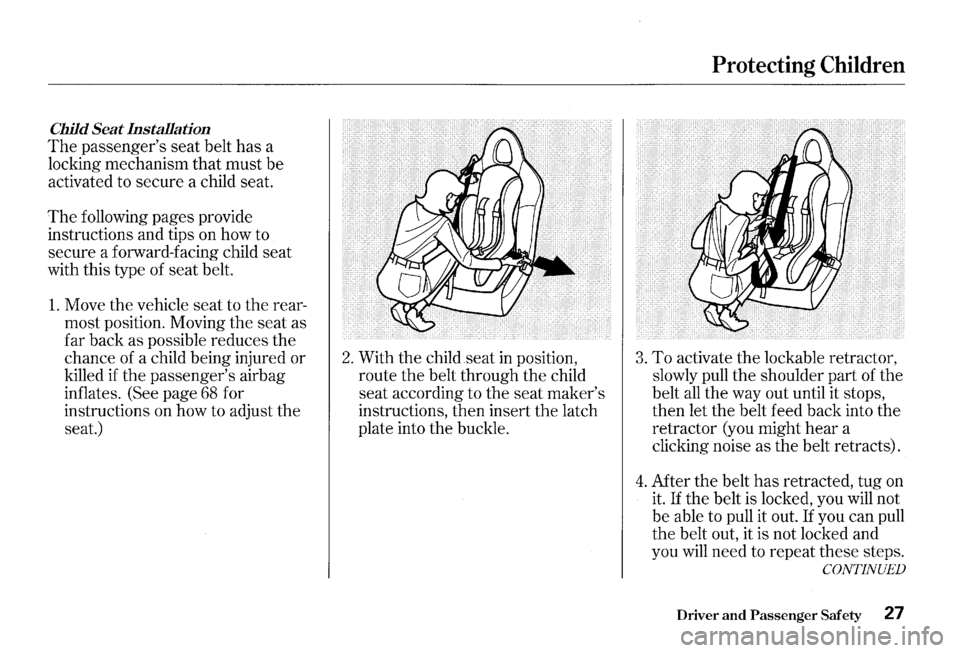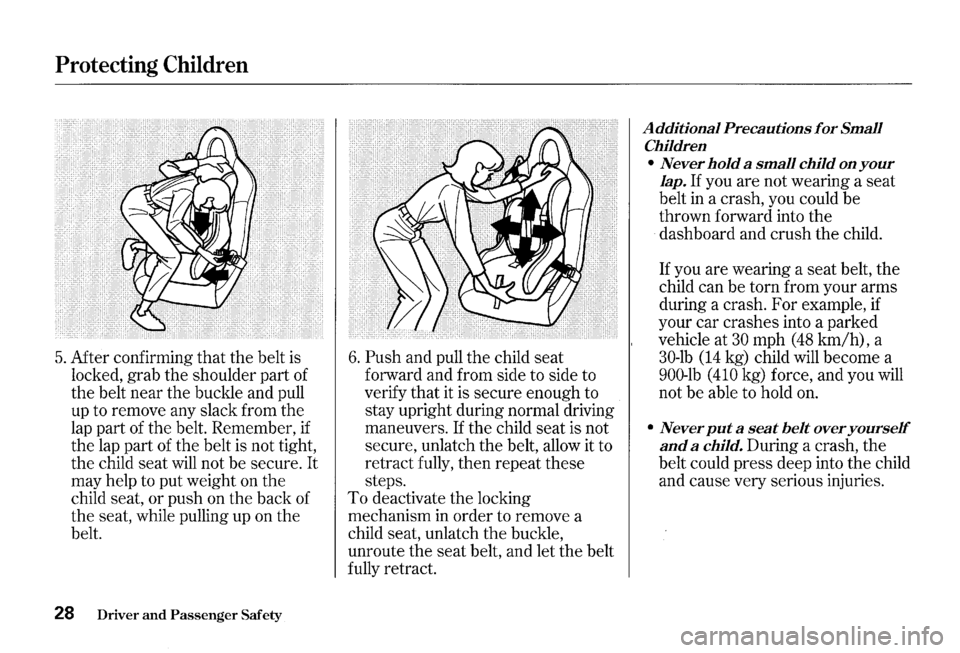2000 HONDA S2000 lock
[x] Cancel search: lockPage 8 of 273

This section gives you important
information about how to protect
yourself and your passenger.
It
shows you how to use seat belts
properly.
It explains your Supple
mental Restraint System. And it tells
you how to properly restrain children
in your car. Important
Safety
Precautions .......... 6
Your Car's Safety
Features .............. 7
Seat Belts ........................................ 8
Airbags ............................................ 9
Seats
& Seat-Backs ...................... 10
Head Restraints ........................... 10
Door Locks ................................... 10
Pre-Drive Safety Checklist ......... 11
Protecting Adults ............................. 12
1. Close and Lock the Doors ...... 12
2. Adjust the Front Seats ............ 12
3. Adjust the Seat-Backs ............. 13
4. Fasten and Position the Seat
Belts ......................................
15
5. Maintain a Proper Sitting
Position ................................. 16
Advice for Pregnant Women ...... 17
Additional Safety Precautions .... 18
Protecting Children ......................... 19
All Children Must Be
Restrained ................................
19
Your Car is Not Recommended
for Child
Passengers ............... 20
The Passenger's Air bag Poses
Serious Risks to Children ....... 20
Additional Safety Precaution ...... 22
Driver and Passenger Safety
General Guidelines for Using
Child Seats ................................
22
Protecting Small Children .......... 26
Protecting Larger Children ........ 29
Additional Information About Your
Seat Belts ..................................
33
Seat Belt System Components ... 33
Lap/Shoulder Belt.. ..................... 33
Seat Belt Maintenance ................ 34
Additional Information About Your
SRS ............................................ 35
SRS Components ......................... 35
How Your Air bags
Work ............ 35
How
the Automatic Seat Belt
Tensioners Work ..................... 37
How
the SRS Indicator Light
Works ........................................ 37
SRS Service ................................... 38
Additional Safety
Precautions .... 38
Carbon Monoxide Hazard .............. 39
Safety Labels ....................................
40
Driver and Passenger Safety 5
Page 13 of 273

Your Car's Safety Features
Seats & Seat-Backs
Your car's seats are designed to keep
you in a comfortable, upright
position so you can take full
advantage of
the protection offered
by seat belts and the energy
absorbing materials in
the seats.
How you adjust your seats and seat
backs can also affect your safety.
For
example, sitting too close to the
steering wheel or dashboard
increases the risk of you
or your
passenger being injured by striking
the inside of the car, or by an
inflating airbag.
Reclining a seat-back too far reduces
the seat belt's effectiveness and
increases
the chance that the seat's
occupant
will slide under the seat
belt
in a crash and be seriously
injured.
10 Driver and Passenger Safety
What you should do: Move the seats
as far back as possible, and keep
adjustable seat-backs in an upright
position whenever
the car is moving.
Head Restraints
Head restraints can help protect you
from whiplash and other injuries.
Door Locks
Keeping your doors locked reduces
the chance of being thrown out of
the car during a crash.
It also helps
prevent occupants from accidentally
opening a door and falling out, and
outsiders from unexpectedly opening
your doors.
Page 14 of 273

Pre-Drive Safety Checklist
To make sure you and your
passenger get the maximum
protection from your car's safety
features, check the following each
time before you drive
away:
• You and any adult passenger, or a
larger child who has outgrown
child seats, are wearing your seat
belts and wearing
them properly
(see page
15 ) .
• A small child riding in a forward
facing child seat is properly
restrained (see page
26).
• Occupants are sitting upright and
as far back as possible from
the
steering wheel and dashboard
(see page
12 ) .
• Seat-backs are upright (see page
13 ).
• Both doors are closed and locked
(see page
12 ).
• All cargo is properly stored or
secured (see page 124).
The rest of this section gives more
detailed information about how you
can maximize your safety.
Remember, however, that
no safety
system can prevent
all injuries or
deaths that can occur in severe
crashes, even when seat belts are
properly worn and the air bags deploy.
Your Car's Safety Features
Driver and Passenger Safety 11
Page 15 of 273

Protecting Adults
Introduction
The following pages provide
instructions on how to properly
protect adult occupants.
These instructions also apply to a
child whom you have decided is
large enough and mature enough to
ride as a passenger. (See page
29 for
important additional guidelines on
how to properly protect larger
children.)
1. Close and Lock the Doors
After everyone has entered the car,
be sure the doors are closed and
locked.
12
Driver and Passenger Safety
~ Your car has a door
~ monitor light on the
instrument panel to indicate when a
specific door is
not tightly closed.
For safety, locking the doors reduces
the chance
that a passenger,
especially a child,
will open a door
while the car is moving and
accidentally fall out.
It also reduces
the chance of someone being thrown
out of the car during a crash.
For security, locked doors can
prevent an outsider from
unexpectedly opening a door when
you come to a stop.
See page
58 for how to lock the
doors.
2.Adjust the Front Seats
Any driver who sits too close to the
steering wheel is at risk of being
seriously injured or killed by striking
the steering wheel,
or from being
struck by an inflating airbag during a
crash.
Page 16 of 273

To reduce the chance of injury, wear
your seat belt properly, sit upright
with your back against the seat, and
move the seat as far back as possible
from
the steering wheel while still
maintaining full control of the car.
Also make sure your passenger
moves the seat as far to
the rear as
possible.
Sitting too close to an airbag
can
result in serious injury or
death it the airbags
inflate.
Always
sit as tar back from the
airbags as
possible.
Most shorter drivers can get far
enough away from the steering
wheel and still reach the pedals.
However, if you are concerned about
sitting too close, we recommend that
you investigate whether some type
of adaptive equipment may help.
Once your seat is adjusted correctly,
rock it back and forth to make sure
the seat is locked in position.
See page 68 for how to adjust the
seats.
3.Adjust the Seat-Backs
Adjust the driver's seat-back to a
comfortable, upright position,
leaving ample space between your
chest and the airbag cover in the
center of the steering wheel.
If you
sit too close to the steering wheel,
you could be injured
if the airbag
inflates.
Protecting Adults
A passenger should also adjust the
seat-back to an upright position, but
as far from
the dashboard as
possible. A passenger who sits too
close to the dashboard could be
injured if the airbag inflates.
CONTINUED
Driver and Passenger Safety 13
Page 30 of 273

Child Seat Installation
The passenger's seat belt has a
locking mechanism that must be
activated to secure a child seat.
The following pages provide
instructions and tips on how to
secure a forward-facing child seat
with this type of seat belt.
1. Move the vehicle seat to the rear
most position. Moving the seat as
far back as possible reduces the
chance of a child being injured or
killed
if the passenger's airbag
inflates. (See page
68 for
instructions on how to adjust the
seat.)
2. With the child seat in position,
route the belt through the child
seat according to the seat maker's
instructions, then insert the latch
plate into the buckle.
Protecting Children
3. To activate the lockable retractor,
slowly pull the shoulder part
of the
belt
all the way out until it stops,
then let the belt feed back into the
retractor (you might hear a
clicking noise as the belt retracts).
4. After the belt has retracted, tug on
it. If the belt is locked, you will not
be able to pull it out.
If you can pull
the belt out, it is not locked and
you
will need to repeat these steps.
CONTINUED
Driver and Passenger Safety 27
Page 31 of 273

Protecting Children
5. After confirming that the belt is
locked, grab the shoulder part of
the belt near the buckle and pull
up to remove any slack from the
lap part of the belt. Remember,
if
the lap part of the belt is not tight,
the child seat
will not be secure. It
may help to put weight on the
child seat, or push on the back of
the seat, while pulling up on the
belt.
28 Driver and Passenger Safety
6. Push and pull the child seat
forward and from side to side to
verify that it is secure enough to
stay upright during normal driving
maneuvers.
If the child seat is not
secure, unlatch the belt, allow it to
retract fully,
then repeat these
steps.
To deactivate the locking
mechanism
in order to remove a
child seat, unlatch
the buckle,
unroute the seat belt, and let the belt
fully retract.
Additional Precautions for Small
Children
• Never hold a small child on your
lap. If you are not wearing a seat
belt
in a crash, you could be
thrown forward into the
dashboard and crush the child.
If you are wearing a seat belt, the
child can be torn from your arms
during a crash. For example,
if
your car crashes into a parked
vehicle at
30 mph ( 48 km/h), a
30-lb (14 kg) child will become a
900-lb (410 kg) force, and you will
not be able to hold on.
• Never put a seat belt over yourself
and a child. During a crash, the
belt could press deep into the child
and cause very serious injuries.
Page 36 of 273

Seat Belt System Components
Your seat belt system includes lap/
shoulder belts in both seating
positions.
The seat belts are also equipped with
automatic seat belt tensioners.
~ The system also includes a
l±J light on the instrument
panel to remind you and your
passenger to fasten your belts.
If the
driver's seat belt is not fastened
before the ignition is turned
ON (II),
the light will come on and a beeper
will also sound.
The beeper will stop
after a few seconds,
but the light will
stay on until the driver's seat belt is
fastened.
Additional Information About Your Seat Belts
Lap/Shoulder Belt
This seat belt has a single belt that
goes over your shoulder, across your
chest and across your hips.
To fasten the belt, insert the latch
plate into the buckle, then tug on the
belt to make sure the buckle is
latched.
To unlock the belt, push the red
PRESS button on the buckle. Guide
the belt across your body to the door
pillar. After exiting the car, be sure
the belt is out of
the way and will not
get closed in the door.
Both seat belts have an emergency
locking retractor.
In normal driving,
the retractor lets
you move freely
in your seat while it
keeps some tension on the belt.
During a collision or sudden stop,
the retractor automatically locks the
belt to help restrain your body.
The passenger's seat belt has an
additional locking mechanism that
must be activated to secure a child
seat. (See page
27 for instructions on
how to secure a forward-facing child
seat with this type of belt.)
If the shoulder part of the belt is
pulled
all the way out, the locking
mechanism will activate.
The belt
will retract, but it will not allow the
passenger to move freely.
CONTINUED
Driver and Passenger Safety 33